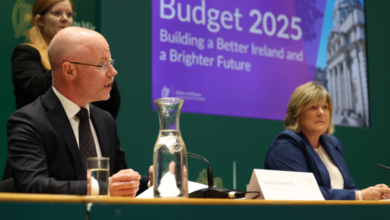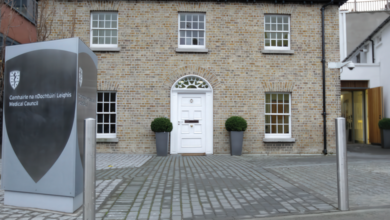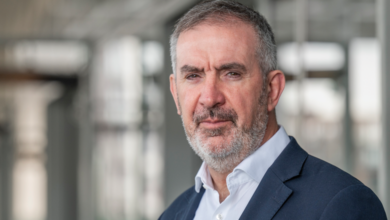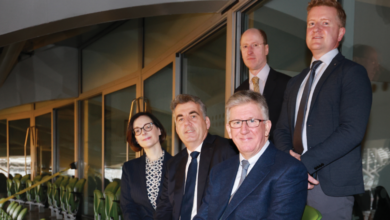Digital transformation for resilience and better healthcare

Gar Mac Críosta, Product Manager for the Health Service Executive (HSE) and Product Lead for the Covid Tracker Ireland app, reflects on the experience of digital transformation during the pandemic and how it has informed a future vision of a more resilient health system.
“It has been a really interesting experience over the last year-and-a-half to see what we could do in the time we were given,” Mac Críosta begins. “We are now in a moment of reflection, figuring out what we bring forward, what we leave behind, and what are the constraints.”
Capacity in the HSE has been severely tested during the pandemic, and Mac Críosta says that high demand is something the health system understands it must learn to live with. Furthermore, the HSE must use the opportunity to not just change technologically, but psychologically: “In healthcare, we have experienced massive demand that we know is not changing and we must determine how to avoid being overwhelmed. It is a fact that we are going to have to deal with the demand and in order to do that we have got finite capacity in our physical structures, so how do we rethink the delivery of healthcare in a sustainable way?
“Before Covid, I felt like I had spent 25 years adding technology to existing processes and not really making too much progress. We were stuck, not in terms of the technology we were deploying, but in terms of the way we were thinking about this.
“After Covid, we have a choice to go back to the status quo, and there are a lot of people who would feel comfortable with that because we were safe there. However, if we move into this new world of continuous change, that brings with it a lot of other things. One of the common framings of digital transformation is changing from A to B. That is a poor framing. Digital transformation is changing the way we think, not changing the thing we are in any given moment. That is one of the big steps we need to take.”
Problems emerge, Mac Críosta says, when technologies that were considered significant changes 20 years ago are now complicating modernisation attempts. A need to be more brutal with regard to these issues is one that the Product Manager touches on.
“It all becomes intertwined and difficult to remove,” he says. “Even now as we deploy new technologies, you add time to it, and you get instant legacy issues and things go on life support. Technologies are livestock, you kill them when it is time and you move on, but we treat them like pets and nurse them, look after them, keep them alive for way too long and that causes stress and despair.”
From their experiences with the pandemic, Mac Críosta and his colleagues have developed three laws of operation:
- Hardware will fail: “Stuff could fall over; heating units, servers, anything.”
- Software has bugs: “You pay for the software and the bugs come for free. Then it is up to us to fix them. It is part and parcel of this process, and we need to get away from thinking that it is awful and move towards a systemic way of fixing these issues when we find them, because we will find them.”
- People will be people: “People are the greatest source of variance and failure in any system. That is the reality of it. Our job is not to engineer people out of it, but to recognise that this is a frailty in the system and figure out a way to deal with it and how do we support people through that.”
“One of the common framings of digital transformation is changing from A to B. That is a poor framing. Digital transformation is changing the way we think, not changing the thing we are in any given moment. That is one of the big steps we need to take.”
A common theme identified by those implementing digital transformation amid Covid is the speed at which change has happened. Mac Críosta is no different, remarking upon how the pandemic has changed perceptions of both how and when to act, he asserts: “There is such a thing as being too late, there is no time for apathy or complacency. This is a time for vigorous and positive action. As a result of Covid Tracker Ireland, we have had lots of conversations that span many government departments and there is consensus there is an opportunity now that we have never had before.
“We never had it but, both from a technological and an urgency point of view, there is a feeling that we need to do something now. One of the big things is energy. The problem with our thinking is that we have spent the past 30 years figuring out how to do complicated things, from an order perspective all we have done is plan, treat the future as predictable, and work through it. Over the past 18 months, we have proved that does not work. I am not saying it does not work for everything, but in certain situations, particularly where there are people involved, you have to employ different techniques. We cannot do the same things as before.”
“There is nothing wrong with old technology; old fragile technology is the problem. We keep mischaracterising things, applying one label to everything else, saying old is bad and then rationalising and getting rid of everything. It is not that simple.”
Energy, Mac Críosta reflects, can be key in such transformations. Too many transformations are often stopped in their tracks due to too much energy demand. As such, the transformations targeted are too big in scope. “If you look at any change or transformation, the reason it does not stick is because the energy gradient is too high, what you are trying to do requires too much effort and unless you lower the energy gradient, you cannot make that move,” he says.
“Over and over again, we see these grand programmes of change failing because the energy gradient is too high. Energy gradients within a system constrain what you can do.”
Significant amounts of energy may be expended by Mac Críosta and his colleagues in dealing with older technologies, but a blanket perception of old as bad is one that he warns against, stating that fragility is the main issue of the day with technology. Age, in the case of resilient technologies, appears to be just a number, and understanding this requires a change in the way we learn.
“There is nothing wrong with old technology; old fragile technology is the problem,” he says, adding: “We keep mischaracterising things, applying one label to everything else, saying old is bad and then rationalising and getting rid of everything. It is not that simple.
“In a complex domain, I have got to probe, experiment, and learn, so it is a learning environment, whereas an ordered environment is a knowing environment. These are two opposing philosophies: One where I know everything and another where I am learning what I need to learn to create some coherence and begin to develop some knowledge. We are stuck in that, and this thinking goes back to school. We are taught to know things, not learn things. We talk about learning, but we do not examine things and that drives a particular perspective on things.”
Reflecting on this lack of critical thinking, Mac Críosta concludes with what he believes to be the crucial aspect to digital transformation: “Imagination is the key in this. Nobody thinks about imagination in terms of decision-making but if I have no imagination, I have no options. Imagination is thinking about what could happen. What would it be like, in terms of delivery of healthcare in Ireland, if we could deliver it anywhere in the country at any point of time to anyone in collaboration with any other department that is out there? What would that look like? That’s totally reimagining how we deliver public services.”





